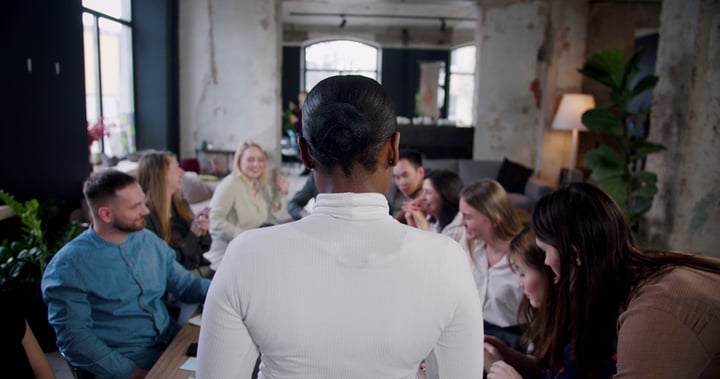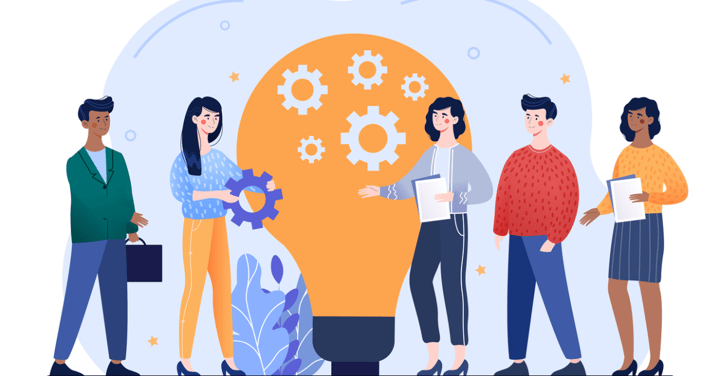Defining DEI: What Are Some Key Terms I Should Know? (Pt 2)
We began exploring why we should talk about DEI in organizational strategy and what some key terms are in this discussion last week. We also fine-tuned what each of the words Diversity, Equity, and Inclusion means and why the three go hand-in-hand.
This week, we will build on last week’s learning by tackling some important terms that we hear often in DEI conversations. These include: “allyship,” “intersectionality,” “privilege,” “microaggressions,” and “micro-affirmations.”
If you are unsure what these words exactly mean and how they can be applied in our thinking about DEI, you are in the right place!
Think of your learning process as receiving a tour to a complex and robustly moving production facility. If last week, we examined the larger structures, this week, we are exploring the smaller, yet essential cogwheels that generate the impact of DEI.
Let’s break each of these terms down one by one.
What is allyship, and how do I become an ally?
Allyship means actively promoting and working to advance the inclusion of marginalized or disadvantaged groups when you are not a member of such groups.
Being an ally entails intentional and consistent efforts to give support, which can include:
- Speaking up for others when you witness unfair treatment,
- Growing your organization’s awareness of the inequities facing disadvantaged groups, or
- Simply listening to and holding space for the experiences of marginalized colleagues, whose experiences may be different from your own.
It’s important to understand that allyship is not self-defined. Your work and efforts must be recognized by those you seek to be an ally to. As you can imagine, being an ally requires deep humility and a willingness to learn about others’ experiences, even when it feels uncomfortable.
The next 3 questions will break down some other ideas that are important to understand if you want to become an effective ally.
What is intersectionality?
Given that each person is made up of various dimensions of diversity, multiple forms of discrimination (such as racism, sexism, classism, or ablism) can combine to have different and cumulative effects on individuals. The dimensions of our diversity intersect and shape our experience of the world. This is intersectionality.
For example, a Black woman’s experience of sexism may be different from a white woman’s experience due to the combined effects of racism. The experiences of disability combined with conditions of poverty are different from persons not exposed to overlapping barriers. Similarly, individuals’ experiences of gender or sexual orientation can be vastly different based on their race, ethnicity, age, and religion.
Understanding intersectionality helps us to recognize that even if we share some barriers with others, their experiences of disadvantages may be vastly different from our own. It also allows us to see the diverse communities that we can be allies too. For instance, white women can be allies to people of colour, men (of various race and ethnicities) can be allies to women, abled individuals can be allies to those with different physical or neurological abilities, and so on.
What is privilege, and how do I know that I have it?
The simplest way to think about privilege is to consider the advantages we experience out of luck or happenstance. Even if we are disadvantaged in some ways, we still hold advantages in others.
As an example, while a person of colour may face barriers based on their race or ethnicity, they may experience advantages as an abled person or as a result of their sexual orientation being commonly accepted. A woman may experience disadvantages based on their gender, but may have privileges based on their religion, race, ethnicity, class, or even speaking English as a first language.
Like intersectionality, recognizing our privileges helps us to notice the ways that we can use our advantages and power to lift others up. Privilege is not something to be embarrassed or ashamed about, it is simply a condition of being. Accepting this can help us to utilize our privileges as a tool for greater allyship and inclusion.
What are microaggressions? How can we turn them into micro-affirmations?
Last but definitely not least, microaggressions are small comments or actions that unconsciously or unintentionally harm or reveal a prejudiced attitude against marginalized individuals. Examples of microaggressions can include verbal slights, insulting jokes, stereotyping, undermining, devaluing, or excluding someone.
Microaggressions are dangerous because they build up over time and leave individuals feeling alienated and alone. They can severely impact employees’ psychological health and wellbeing. It takes a conscious and committed effort to eradicate microaggressions because often they are actions or comments made with little knowledge or concern about their impact.
An effective way of eliminating microaggressions is by replacing them with micro-affirmations. A micro-affirmation is a small act or words of inclusion and kindness.
Examples include providing comfort and support, ensuring that all team members are heard in meetings, listening to others’ experiences, and asking questions (respectfully, without feeling entitled to an answer) to expand our knowledge.
Turning microaggressions into micro-affirmations helps us to replace unconscious actions with intentional ones and to build a culture of inclusion, one small moment at a time. They are a great place to start with your allyship efforts.
Congratulations on your foundational learning about DEI! If you are interested in learning more, check out the previous weeks’ posts on unconscious bias (Part 1 and Part 2) and the Harvard Human Resources’ Glossary of Diversity, Inclusion, and Belonging Terms.
Of course, The Humphrey Group’s DEI programs offer a more comprehensive learning experience to enhance your knowledge. Explore the learning experiences today and find out which programs may be best suited to your and your organization’s needs.
Related Posts
Defining DEI: What Are Some Key Terms I Should Know? Part 2
Deepen your understanding of DEI with essential terms: allyship, intersectionality, privilege, microaggressions, and micro-affirmations. Learn how to be an effective ally and create an inclusive culture
Read MoreDefining DEI: What Are Some Key Terms I Should Know? (Pt 1)
Today, the goals of DEI include promoting a diverse workforce, increasing fairness in organizations, and ensuring that all employees feel valued.
Read MoreLeadership Development and DEI Training: What is the Relationship?
At The Humphrey Group, we believe that inclusion training is and should be a core part of leadership development.
Read More

